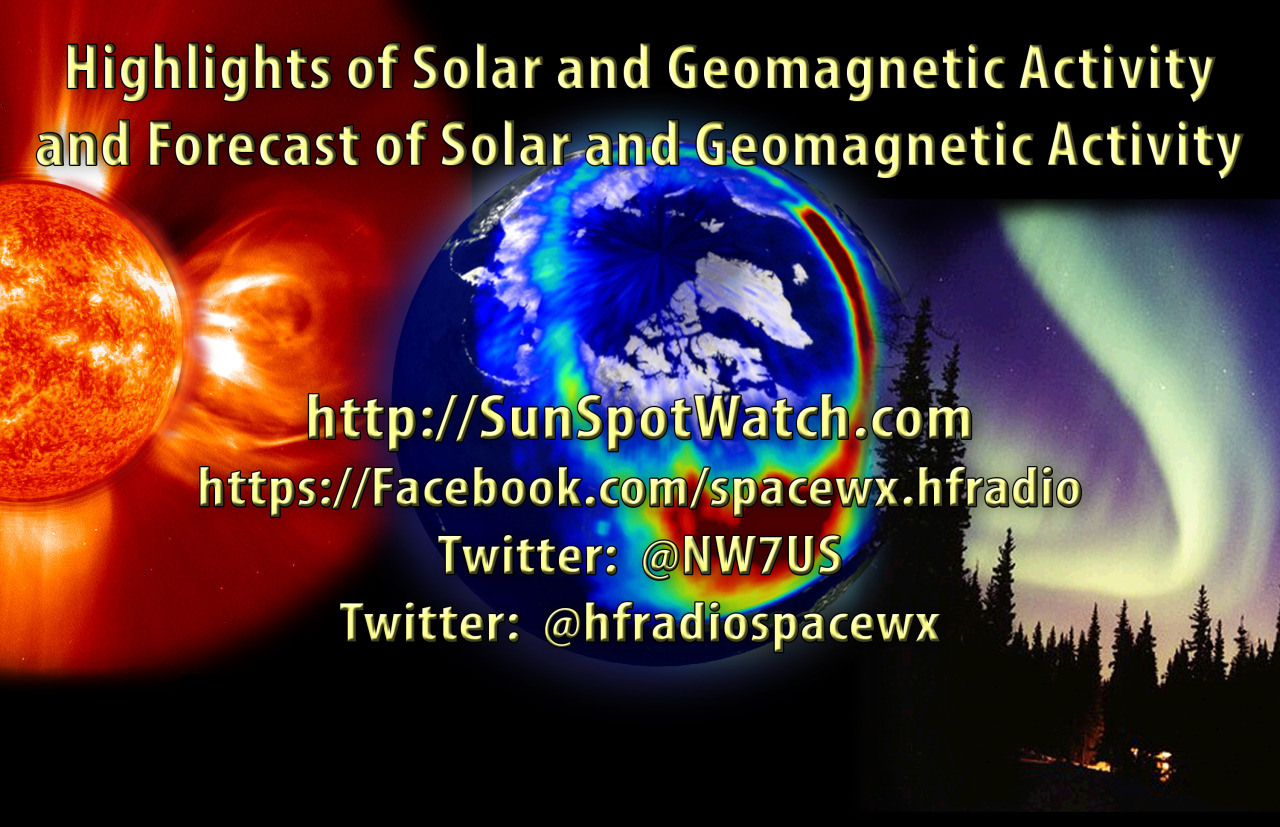 Weekly Propagation Summary – 2015 Jun 22 16:10 UTC
Weekly Propagation Summary – 2015 Jun 22 16:10 UTC
Here is this week’s space weather and geophysical report, issued 2015 Jun 22 0548 UTC.
Highlights of Solar and Geomagnetic Activity 15 – 21 June 2015
Solar activity was at low to moderate levels. Weak to mid-level C-class flares were observed on 15-17 Jun from Regions 2360 (N15, L=129, class/area Eac/220 on 12 Jun), 2367 (S20, L=002, class/area Ekc/400 on 15 Jun), 2268 (S06, L=100, class/area Bxo/010 on 14 Jun) and 2371 (N13, L=302, class/area Fkc/1180 on 21 Jun). Activity increased to moderate levels (R1-minor) on 18 Jun. Old Region 2365 (S13, L=079) produced a long duration event (LDE) M1 flare at 18/0127 UTC. At 18/1736 UTC, Region 2371 produced an M3/1n LDE with associated Type IV and Tenflare (2200 sfu) radio emissions. Associated with this event was an asymmetric, full-halo CME first visible in LASCO C2 imagery at 18/1724 UTC.
19 Jun saw a return to low levels with weak to high-level C-class flares observed from Region 2371. At about 19/0500 UTC, a large filament eruption was observed in the SSE quadrant of the disk. Associated with this eruption was a partial-halo CME, first observed in LASCO C2 imagery at 19/0845 UTC. Moderate levels returned on 20 Jun with an M1/if flare observed at 20/0648 UTC. 21 Jun saw a total of 4 M-class class flares. Region 2371 produced an M2/1n flare at 21/0142 UTC with associated Type II (682 km/s) and Type IV radio emissions. Also associated with this event was a full-halo CME. Shortly afterward, this same region produced an M2.6 x-ray event. At 21/0944 UTC, Region 2367 produced an M3/2b flare followed by an M1 x-ray event at 21/1820 UTC.
A pair of 10 MeV at greater than or equal to 10 pfu proton events were observed at geosynchronous orbit. The first event began at 18/1135 UTC, reached a maximum of 16 pfu at 18/1445 UTC and ended at 19/0230 UTC. This event was associated with the M1 flare from old Region 2365 observed at 18/0127 UTC. The second event began at 21/2035 UTC and reached at peak of near 50 pfu at the end of the summary period and was still rising. This event was associated with the M1 flare from Region 2367 observed at 21/1820 UTC.
The greater than 2 MeV electron flux at geosynchronous orbit reached high levels through the entire summary period.
Geomagnetic field activity was at quiet to active levels through the period. Quiet to unsettled levels were observed on 15-17 Jun with isolated active periods observed on 15 and 17 Jun. This activity was due to positive polarity coronal hole high speed stream (CH HSS) effects. Solar wind parameters, measured at the ACE satellite, indicated wind speeds of near 600 km/s early on 15 Jun decreasing to about 450 km/s by the end of the 17th. Total field ranged between 4-8 nT while the Bz component varied between +/- 5 nT. Phi angle was in a predominately positive (away) orientation. Predominately quiet conditions were observed on 18 Jun through late on 21 June. Solar wind speeds decreased from about 450 km/s early on 18 June to near 275 km/s by 21/1540 UTC. During this same time frame, total field ranged between 1-6 nT, Bz varied between +4 nT to -3 nT and phi remained mostly positive. After 21/1540 UTC, wind speed increased to about 360 km/s, Bt increased to 12 nT, Bz varied between +8 nT to -7 nT and phi briefly rotated to a negative (towards) sector. This deviation indicated a possible co-rotating interaction region in advance of an anticipated positive polarity CH HSS.
Forecast of Solar and Geomagnetic Activity 22 June – 18 July 2015
Solar activity is expected to be at moderate to high levels (R1-R2, minor-moderate). Active Regions 2367 and 2371, and the return of old Region 2365 on 30 Jun, are expected to keep activity levels enhanced through the outlook period.
The 10 MeV at greater than or equal to 10 pfu proton flux at geosynchronous orbit is expected to remain at the S1 (minor) to S2 (moderate) levels through 24 Jun. Effects from the 21 Jun M1 flare, coupled with multiple shocks from the 18, 19 and 21 Jun CMEs, are expected to keep proton flux above event levels.
The greater than 2 MeV electron flux at geosynchronous orbit is expected to be at normal to moderate levels on 22 Jun through 06 Jul. Moderate to high levels are expected on 07-18 Jul due to CH HSS effects.
Geomagnetic field activity is expected to be at unsettled to severe storm levels (G1-G3, minor-strong) on 22-24 Jun. This activity is due to the expected arrival of the three CMEs from 18, 19 and 21 Jun. Unsettled to active periods are expected on 06-08 Jul, 12-13 Jul and 18 Jul, along with minor storm periods (G1-minor) on 05 and 11 Jul, due to CIR/CH HSS effects. Predominately quiet to unsettled levels are expected for the remainder of the outlook period.
Don’t forget to visit our live space weather and radio propagation web site, at: http://SunSpotWatch.com/
Live Aurora mapping is at http://aurora.sunspotwatch.com/
If you are on Twitter, please follow these two users: + https://Twitter.com/NW7US + https://Twitter.com/hfradiospacewx
Get the space weather and radio propagation self-study course, today. Visit http://nw7us.us/swc for the latest sale and for more information!
Check out the stunning view of our Sun in action, as seen during the last five years with the Solar Dynamics Observatory (SDO): https://www.youtube.com/watch?v=zXN-MdoGM9g
We’re on Facebook: http://NW7US.us/swhfr













